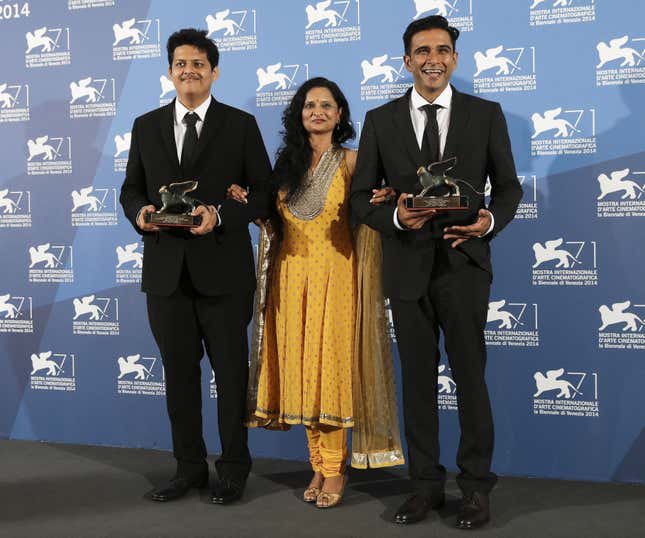Around this time last year, the makers of Court had just returned from Italy. The multilingual film had premiered at the Venice International Film Festival and won two awards—for the best first-time director and the best debut film.
Now, after many more screenings at film festivals and many more prizes, including a National Award for the best feature, the film is headed to the US as India’s official entry to the Oscars.
“You know the crazy part? The film wasn’t even supposed to exist till six months ago,” Vivek Gomber, one of the lead actors and producer of Court, said in an interview to the Huffington Post in April. “We got so lucky.”
However, the film’s selection as India’s official entry is just the beginning of Court‘s journey to the Oscars.
Typically, a foreign film goes through two phases of selection: In the first round, nine films are shortlisted out of entries sent from across the world. In the next round, the shortlist is whittled down to five.
In the first phase of film screenings, held between October and January, members of the Academy’s general committee are invited to rank the films on a scale of six to 10. That’s how the top six films are selected. Three more are added as per the recommendation of a special committee. In the second round, all nine films are screened in New York, London and Los Angeles, and five are shortlisted.
What can—and does—influence the first round is the film’s popularity in the US, achieved through rigorous campaigning, lobbying, and publicity.

“You need to create awareness, and so a campaign has to be built around the film,” a producer whose film was recently India’s Oscar entry told Quartz, requesting anonymity. ”How do you get more and more bums on the seat? And that’s where an integrated, 360-degree marketing blitzkrieg needs to happen.”
Since money is so crucial to create a successful campaign, an Oscar entry is like a white elephant for an art house film, explained Geetu Mohandas, director of Liar’s Dice, India’s official entry for the Oscars in 2015.
“For an independent film like Liar’s Dice, it was hard enough to just secure financing. It alone took me seven years,” Mohandas said.
“(For the Oscars), you have no support from any quarter, and you need to raise a lot of money in a very short span of time.”
Among other things, directors need to pay publicists who handle the campaign. Typically, they know who the members of the Academy are, what publications they are reading, how to carry out the screenings, and so on.
“Each publicist will have at least five to six films that they represent all over the world. So it’s not that they are exclusively your property,” Mohandas told Quartz.
“And it’s not like we choose them, they choose us. They themselves do a certain amount of homework. They watch the film and then they decide if they want to be associated with this particular film.”
Alongside, the films hope to find distributors in the US to ensure as many screenings as possible.
So far, only three Indian films have made it to the top five: Mother India, Salaam Bombay! and Lagaan. None of them has won.
Long road to Oscars
In 1957, Mehboob Khan’s Mother India was the first Indian film to make the cut and be shortlisted for the top five films in the foreign language category at the Oscars.
In a 2002 interview to India Today, Khan’s son, Shaukat, recalled the filmmaker’s visit to the US: ”I remember my dad telling us on his return that once he got there he realised you needed to do some marketing, that there was a lot of behind-the-scenes activity.”
Forty five years after Mother India, Bollywood actor Aamir Khan, backed by a powerful public relations company, showed India how it is done.
“Basically, we are trying to get as many members as possible to see the film,” the actor said in a 2002 interview to the India Today magazine from Los Angeles ahead of the Oscars. “That’s what we did in the first round, and we let the film do the talking.”
Lagaan’s publicity was helped by several interviews that Khan gave in the US and full-page advertisements (each costing up to $15,000) in leading American media publications. Ultimately, Lagaan became the only third Indian film to be selected as the top five nominees.
The estimated cost just for Lagaan’s Oscar publicity, more than a decade ago, was $2 million. In comparison, Court was made on a shoestring budget. The director reportedly received about 10,000 euros (Rs7.45 lakh) in funding from Rotterdam’s Hubert Bals Fund, and the remaining Rs3.5 crore was Gomber’s own contribution.
“Such films (like Lagaan) don’t have to worry about being in debt,” Mohandas said. “Like, you have to pay the publicist in dollars every time that you go up the ladder and come closer to the Oscar. So by the time I would have won the Oscar, I would be out on the street.”
In India, art houses are gradually becoming popular, but still lack exposure. Court, for instance, released in only about 150 screens across India, compared to Bollywood productions releasing on an average of 2,000 screens.
“There are so many nations that support the Oscar entry… raise money. There’s no provision in India,” Mohandas told Quartz. “It’s all about, ‘Namaste, go and win it for us and come back.’ It’s never like what next, what can we do?”
